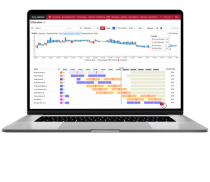- Products
- Solutions
Solutions
Services
- Resources
- Customers
Explore CSCCalabrio Success Center
Calabrio product training
- Partners
Customer ExperienceFind More Great Content- Customer Interaction Analytics
- Workforce Management
- Customer Experience
- Quality Management
- Contact Center Reporting
- Managing a Remote Workforce
Home » Workforce Optimization » Resistance to change – the arch nemesis of customer experience
Resistance to change – the arch nemesis of customer experience
According to Patrik Vesterberg at Calabrio, tried and tested isn’t always best. Here, he explains why change is good and outlines a flexible philosophy to kickstart the transformation of your customer interactions.
Change comes in many forms, new people, new ways of doing things and new technology, in fact, anything that threatens the status quo, and it can strike fear into the bravest of souls. Fear of the unknown and fear of disempowerment are two reactions. The third is quite simply that taking the “but we have always done it this way” route means a lot less effort and makes life easy. But does it?
The truth is resistance to change has long-term limitations and can even signal the death knell for organizations. For instance, if today’s multi-channel customer engagement centers had not morphed from simple call centers to something much broader, many companies could have lost the majority of their customers and gone out of business a long time ago. It’s a sobering thought.
A guide to survival
Rather like the Darwinian theory of evolution, only the fittest survive and this comes down to adaptability. In modern terms, the ability to do more with less differentiates the winners and the losers. Customer satisfaction is fast becoming the most popular measure of success for modern organizations in a world where there is a trend towards declining brand loyalty. It’s a fine balance between keeping a grip on all resources and meeting the round-the-clock needs of today’s consumer. How do organizations achieve it? Flexibility is the name of the game.
Five ways to future-proof customer service
1. News ways of working
Digital channels including email, web chat, instant messaging and social media are now accepted channels for service provision and their use is being driven by customer demand. In a recent survey by industry analyst, ContactBabel over 90% of the respondents described their customer service as either multi-channel or omni-channel ie they offered more than telephone or postal support. The desire to provide 24/7, fast and simple service means that organizations are searching for ways to power this without huge resourcing investment. Answers include the provision of self-service options, introducing automated artificial intelligence (AI) bots and allowing people to work from home and flexible employee contracts.
All forms of flexible working make sound business and operational sense. They allow an organization to flex their customer care muscle when most needed.
2. Cascade the customer message and remodel KPIs
Keep people informed and cascade the customer message throughout the organization. Customer service goals in each department should support the overall corporate goal. To help reinforce this it may be necessary to remodel key performance indicators, those measurable values that demonstrate how effectively goals and objectives are being achieved. Consider switching from traditional KPIs such as revenue targets, average handling time (AHT) or Net Promoter Scores to concentrate on customer satisfaction (CSat) metrics.
3. Involve and devolve
During times of organizational change or simply when there is high customer demand, it’s tempting to operate and take decisions in isolation. If new technology is introduced, encourage the whole team to establish how the system can best be configured to meet their specific needs. Involve them in the decision-making, give them the right tools and the authority to do their job and see customer service soar.
Next, ensure that all departments with direct customer contact work together to close the loop. For example forge relationships between customer service and marketing to find out when the next big campaign will hit the streets so everyone is prepared for an influx of new sales enquiries. Break down barriers and build trust through cross-functional get-togethers or an online forum to exchange knowledge, best-practice, and learning. Customers will pick up on this unity and customer satisfaction will flourish.
4. Really listen to the voice of the customer
Not just at the end of ad-hoc customer surveys but from the very beginning. Listen to front-line staff and encourage them to devise new and improved ways to serve customers and even pre-empt what they will want in the future. Instill a customer first approach that permeates the whole company by eliciting customer stories from all departments e.g. credit control, sales, marketing, and operations – they all deal with people on a regular basis, people who are customers in one way or another. Finally, returning to those customer surveys, make them a living, breathing mechanism and take on board feedback both good and bad, to make meaningful changes to customer interactions.
5. Contextualize customer interactions
Most organizations are reactive when it comes to customer care. Such as in the contact center itself, someone calls in and staff looks up various pieces of information to solve a specific enquiry at a particular period in time. This approach doesn’t take into account any contextual factors that predetermine the outcome of customer interactions. These could include the customer’s bad mood from having been passed from department to department.
The aim should be to capture customer data and apply intelligence to it in four ways. Be contextual, suggestive, pre-emptive and predictive to put the query and the resolution into context. If technical support advises that a customer has spent the last 30 minutes trying to sort out a problem with their new smartphone, an empathetic greeting such as “Hi Joe, I understand you’ve been talking to tech support but it looks like you still haven’t got the answer you need, let me help you…” will go a long way towards calming potentially inflammatory interactions. Pre-empt the way customers like to interact with the company, check out if they prefer email or instant messaging to telephone or email and make the necessary adjustments.
Change the way you work, remodel your KPIs, disband departmental silos and listen to customer feedback and you’ll begin to transform customer experience and overcome that arch nemesis, resistance to change.
Recent PostsCalabrio is a trusted ally to leading brands. The digital foundation of a customer-centric contact center, the Calabrio ONE workforce performance suite helps enrich and understand human interactions, empowering your contact center as a brand guardian.
We maximize agent performance, exceed customer expectations, and boost workforce efficiency using connected data, AI-fueled analytics, automated workforce management and personalized coaching.
Only Calabrio ONE unites workforce optimization (WFO), agent engagement and business intelligence solutions into a true-cloud, fully integrated suite that adapts to your business.
For customers and partners.
© Copyright 2024 Calabrio, Inc.The Voice of the Service DeskAI in Customer Service: More than Just ChatbotsSend this to a friend - Solutions













